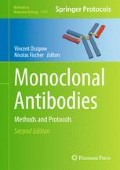Abstract
Monoclonal antibodies (mAbs) represent the largest group of therapeutic proteins with 30 products approved in the USA and hundreds of therapies currently undergoing clinical trials. The complex nature of mAbs makes their development as therapeutic agents constrained by numerous criteria such as quality, safety, regulation, and quantity. Identification of a clonal cell line expressing high levels of mAb with adequate quality attributes and generated in compliance with regulatory standards is a necessary step prior to a program moving to large-scale production for clinical material. This chapter outlines the stable transfection technology that generates clonal cell lines for commercial manufacturing processes.
Access this chapter
Tax calculation will be finalised at checkout
Purchases are for personal use only
References
Li J, Zhu Z (2010) Research and development of next generation of antibody-based therapeutics. Acta Pharmacol Sin 31:1198–1207
Reichert JM (2008) Monoclonal antibodies as innovative therapeutics. Curr Pharm Biotechnol 9:423–430
Schmidt FR (2004) Recombinant expression systems in the pharmaceutical industry. Appl Microbiol Biotechnol 65(4):363–372
Schirrmann T et al (2008) Production systems for recombinant antibodies. Front Biosci 13: 4576–4594
Andersen DC, Krummen L (2002) Recombinant protein expression for therapeutic applications. Curr Opin Biotechnol 13(2): 117–123
Andersen DC, Reilly DE (2004) Production technologies for monoclonal antibodies and their fragments. Curr Opin Biotechnol 15(5): 456–462
Sethuraman N, Stadheim TA (2006) Challenges in therapeutic glycoprotein production. Curr Opin Biotechnol 17(4):341–346
Trill JJ, Shatzman AR, Ganguly S (1995) Production of monoclonal-antibodies in Cos and Cho cells. Curr Opin Biotechnol 6(5): 553–560
Kaufman RJ (2000) Overview of vector design for mammalian gene expression. Mol Biotechnol 16(2):151–160
Wurm FM (2004) Production of recombinant protein therapeutics in cultivated mammalian cells. Nat Biotechnol 22(11):1393–1398
Birch JR, Mainwaring DO, Racher AJ (2008) Use of the Glutamine Synthetase (GS) expression system for the rapid development of highly productive mammalian cell processes. In: Knäblein DJ (ed) Modern biopharmaceuticals: design, development and optimization. Wiley-VCH Verlag GmbH, Weinheim, Germany
Graf LH, Chasin LA (1982) Direct demonstration of genetic alterations at the dihydrofolate-reductase locus after gamma-irradiation. Mol Cell Biol 2(1):93–96
Urlaub G et al (1986) Effect of gamma-rays at the dihydrofolate-reductase locus—deletions and inversions. Somat Cell Mol Genet 12(6): 555–566
Jun SC et al (2005) Selection strategies for the establishment of recombinant Chinese hamster ovary cell line with dihydrofolate reductase-mediated gene amplification. Appl Microbiol Biotechnol 69(2):162–169
Bebbington CR et al (1992) High-level expression of a recombinant antibody from myeloma cells using a glutamine synthetase gene as an amplifiable selectable marker. Biotechnology (N Y) 10(2):169–175
Kingston RE et al (2002) Amplification using CHO cell expression vectors. Curr Protoc Mol Biol chapter 16: Unit 16 23
Birch JR, Racher AJ (2006) Antibody production. Adv Drug Deliv Rev 58:671–685
de la Cruz Edmonds MC et al (2006) Development of transfection and high-producer screening protocols for the CHOK1SV cell system. Mol Biotechnol 34(2):179–190
Author information
Authors and Affiliations
Editor information
Editors and Affiliations
Rights and permissions
Copyright information
© 2014 Springer Science+Business Media, New York
About this protocol
Cite this protocol
Alvin, K., Ye, J. (2014). Generation of Cell Lines for Monoclonal Antibody Production. In: Ossipow, V., Fischer, N. (eds) Monoclonal Antibodies. Methods in Molecular Biology, vol 1131. Humana Press, Totowa, NJ. https://doi.org/10.1007/978-1-62703-992-5_17
Download citation
DOI: https://doi.org/10.1007/978-1-62703-992-5_17
Published:
Publisher Name: Humana Press, Totowa, NJ
Print ISBN: 978-1-62703-991-8
Online ISBN: 978-1-62703-992-5
eBook Packages: Springer Protocols

